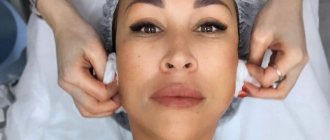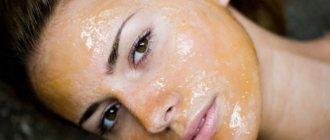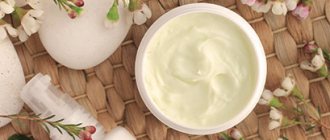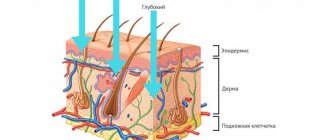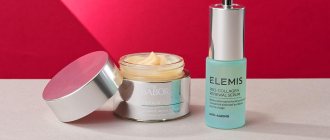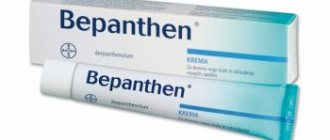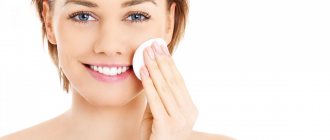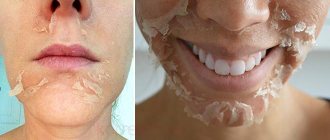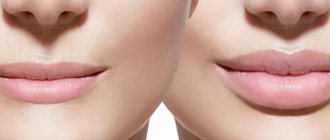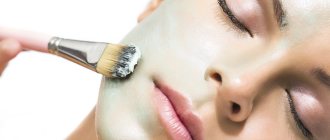Peeling procedures are necessary for complete cleansing and rejuvenation of the skin. Their periodic implementation helps remove the stratum corneum, activate regeneration processes, and stimulate the production of protein fibers that increase the elasticity of the skin. An unpleasant temporary side effect of this type of cosmetic manipulation is redness and peeling. For speedy rehabilitation, you cannot do without a suitable cream after peeling. Many such products contain panthenol, bisabolol, urea, hyaluronic acid, and other chemical compounds that restore and increase tissue moisture. Examples of good cosmetic compositions are presented in this review.
"Christina" - post-peeling cream, loved by specialists
Many professional aesthetic doctors and representatives of beauty salons call Post Peeling Cover Creme from the Rose de Mer series from the mentioned Israeli manufacturer the best moisturizer for the face after peeling. Suitable for all skin types, including those with increased sensitivity. It is famous for its economical use. It has a tonal effect, which is useful for girls who have undergone the procedure to disguise minor redness and other unpleasant defects that remain for some time after its completion.
Recommendations from cosmetologists
During the recovery period, I recommend to my patients the use of a cream that soothes the skin both after medium peeling and during superficial cleansing. I give preference to professional cosmetics, as they contain additional nutritional components. As for the water-lipid balance, my opinion is that it needs to be restored from the inside by increasing the drinking regime to 3 liters per day.
In my practice, I have repeatedly encountered the presence of highly allergenic components in expensive creams. Therefore, I proceed from the fact that the simpler the composition of the product, the lower the risk of developing unwanted reactions. I prefer monocomponent drugs. For example, Panthenol ointment or a cream with the appropriate name do an excellent job of regenerating the skin after peeling: inexpensive but high-quality care. At the same time, it suits almost everyone and rarely causes intolerance. An alternative option is any analogue with the main active ingredient - panthenol.
It is recommended to care for skin exposed to chemicals based on the strength of the acid’s effect on the epidermis. For surface cleaning, a light emulsion based on panthenol is sufficient. If mid-level cleaning was carried out, the care must be supplemented with a product containing hyaluronic acid. During deep acid procedures, the addition of antibiotics is necessary to prevent the risk of possible infection in the post-peeling period. In the latter case, it is advisable to carry out restoration procedures under the supervision of a specialist.
Which cream to use after peeling: tonal calming Peelosophy
Another remedy from Christine has rightly found itself in the top list of the best. Those who have questions about whether they need to apply cream after peeling should use Peelosophy Protective Cover and evaluate the effect of its restorative effect. The composition, dense in texture, which includes extracts of aloe, mountain arnica, oat grains, olive oil, and other components known for their calming effect, helps protect the skin damaged by the procedure, initiate rapid regeneration in it, and mask the resulting redness. Some potential buyers are intimidated by the dark shade, but according to reviews, the product has the ability to adapt to skin tone.
Who needs peeling and why?
Exfoliation helps cleanse and renew the skin by exfoliating it. The procedure activates tissue regeneration and stimulates blood microcirculation. Peeling will help make the skin smooth and elastic, rejuvenate it, restore healthy radiance and freshness.
Depending on the nature of the impact, peelings are divided into
- Physical
– performed using abrasives, i.e. exfoliating particles. - Chemical
- performed using exfoliating agents. They often contain fruit acids. - Hardware
- performed using ultrasound or laser.
There are several types of peeling according to the level of impact: superficial, medium and deep . Superficial peeling affects the epidermis, while medium and deep peeling reaches the dermis.
Superficial peels are suitable for periodic skin renewal, but medium and deep peels can be used to solve cosmetic problems.
According to the principle of action, any peeling is a controlled damage to the skin when you destroy tissue at an acceptable level.
This means that after superficial peeling you can feel freshness and smoothness , and after medium and deep peeling you can eliminate wrinkles and visually rejuvenate your face. It all depends on how much exposure you expose your skin to.
Peeling is needed for those who want to get rid of acne marks ( redness, scars, pigmentation and skin unevenness) and signs of aging (wrinkles, creases, age spots).
Post-peeling cream "Arcadia"
A Russian manufacturer specializing in home and professional cosmetics offers two options for restorative compositions after a painful procedure, in the general “Skin Youth” series. When wondering which cream to prefer after facial peeling, you will have to choose based on the characteristics of the skin. For those with different fat content, one product, for normal or dry ones - others. Among the ingredients you will find well-known natural soothing and regenerating components: soybean, egg oils, extracts of calendula, licorice, chamomile, etc.
What problems can you encounter after the procedure?
- Peeling. If the product used contains lactic acid, peeling will not be pronounced; when cleansing the face with a product containing glycolic acid, separation of the skin into plates is observed.
- Redness. With superficial cleansing, redness disappears after 3-6 hours; with medium cleansing, hyperemia can last up to a week, and deep peeling can cause redness of the skin for up to 6 weeks.
- Swelling. Swelling appears immediately after cleansing and is caused by thin or sensitive skin types. The areas most susceptible to swelling are: nose, neck, décolleté.
- The appearance of acne. Rashes may appear after cleansing problem skin or be a consequence of the wrong type of peeling.
- Age spots and freckles. They appear when cleansing is performed in the summer, during medium or deep cleansing, and also due to the unprofessionalism of the cosmetologist.
- Rash. It occurs due to intolerance to one of the components of the product used in the absence of a timely test to identify allergies.
- Scars or welts. A hard crust may appear after medium or deep exfoliation; with proper treatment of the epidermis, it comes off without side effects; if you remove it yourself, there is a high risk of scar formation.
After deep peeling, a sharp increase in temperature may be observed - if you follow the specialist’s recommendations, such symptoms go away on their own within a few hours.
ABR from Holy Land: suitable cream after chemical peeling
The Israeli manufacturer is famous for its own line of peeling products, which should be used in combination. The answer to a reasonable question, what kind of “Holi Land” cream is needed after peeling, will be answered by every esthetician doctor who is familiar with this cosmetics. ABR Restoring Cream, included in the corresponding series, is especially suitable for such purposes. Contains a high concentration of active components, which allows you to successfully eliminate skin defects. Suitable for everyday use, outside of anti-aging procedures.
Top creams for post-peeling care
High-quality and effective cosmetics, devoid of aggressive ingredients, chemicals and fragrances, will help you care for skin weakened by chemical exposure. We bring to your attention several worthy options for creams that are useful during a difficult period for the skin:
- Probiotic Balancing cream from Holy land cosmetics is a product from the professional cosmetics segment that perfectly soothes inflamed areas, enhances regeneration and protects cells from the aggressive effects of external factors. Its composition is filled with probiotics. The product should be used in the evening after washing. The cost of the drug is from 1700 rubles. Additionally, you can purchase a moisturizing cream from this series (PROBIOTIC Hydrating Cream). Just keep in mind that it contains milk protein and lactose.
- Kanebo Sensai Silk Soothing Cream - a silk complex filled with mineral enzymes, kakiyoku and white lupine extract soften, moisturize and nourish weakened areas of the epidermis, filling them with vital energy. The product is fluid in its lightness, absorbs quickly and does not weigh down the skin. The purchase will cost between 1200–1500 rubles.
- Sisley Confort Extreme Night Skin Care is an elite French cosmetics that will provide high-quality care after the peeling procedure. Using the drug, you will eliminate the unpleasant consequences of cleansing in the shortest possible time. The products are expensive, but the results according to consumer reviews are also excellent.
For those who cannot afford expensive cosmetics, you can use medicinal ointments. They are cheaper, but they effectively treat the problem and do not cause irritation. These products include:
- Panthenol ointment, spray and cream are a budget option. Using the product, you will relieve discomfort, eliminate dry skin, accelerate the regeneration and healing of damaged tissues. The price of the drug in different pharmacies can vary from 37 to 585 rubles, this is also influenced by the form and dosage of the drug.
- Bepanten cream or ointment fills cells with vitamins. The product is recommended for the treatment of abrasions, cracks and burns. Apply the product up to 5 times a day in a thick layer. Some patients complain that the ointment is not absorbed. Despite this drawback, the product has a significant effect on weakened fibers, stimulates regeneration and intensively moisturizes the skin.
Proper care after chemical peeling is the key to the success of the cosmetic procedure and rapid restoration of the skin. The cosmetologist will tell you which cream to use, in what quantity and how often. Follow his instructions without question to achieve the desired results.
Recovery after laser treatment
Choosing a cream after laser peeling requires a particularly careful approach. You should select cosmetics that have a healing effect and at the same time prevent the formation of acne or other unwanted side effects. Therefore, Cicalfat from Avene will be a suitable solution. Having a regenerating effect on the skin, it helps to quickly eliminate tissue damage and rejuvenate them. The antibacterial effect will help avoid infectious lesions to which the skin is sensitive after cosmetic procedures.
Criterias of choice
The main side effects encountered after peeling:
- Redness. Depending on the type and depth of exposure, redness may remain on the face for up to several days.
- Swelling. Those with sensitive and thin skin are susceptible to it. It usually concentrates in the neck and décolleté area.
- Sensitivity. Since peeling is aimed at exfoliating the surface layer of the skin, after the procedure it becomes thinner and there is increased sensitivity in this area.
- Negative effects of the sun. After peeling, the skin must be protected from direct sunlight and special protective agents with SPF 50 or higher must be applied to it.
- Peeling and itching. Depending on how the procedure is performed, peeling may continue for several days. There is also a feeling of tightness.
In the very first days after the procedure, only medicinal ointments and creams are used. They help heal wounds, remove swelling, inflammation, itching and irritation.
The main criteria to pay attention to when choosing:
- the cream should match your skin type and age;
- a minimum of chemicals and fragrances in the composition so as not to cause irritation or an allergic reaction;
- only professional and certified medicinal cosmetics, preferably from the same line.
Read also: Wrinkles on the cheeks?
What components to look for in the composition:
- collagen;
- vitamins A, B, C, E;
- proteins;
- lanolin;
- fruit acids;
- hyaluronic acid;
- vegetable oils of natural origin;
- seaweed;
- proteins;
- snail mucin;
- antioxidants;
- amino acids.
Domestic cream after facial peeling
Worthy of mention in this top list is the product of the Russian brand Medical Collagene 3D, intended specifically for post-peeling care. Post Peel, which has an unobtrusive aroma, will provide protection from ultraviolet radiation due to its high SPF and soften damaged skin. It will reduce pain, inflammation, irritation, and accelerate skin metabolic processes. Native collagen, avocado oil, lecithin, and panthenol contribute to obtaining such effects.
Advantages and disadvantages
Coral peeling is valued for its effectiveness, wide possibilities of the technique, safety, and naturalness of the product. The option is popular among cosmetologists and patients. The procedure can be carried out with the participation of a doctor, or independently at home.
Among the disadvantages of coral peeling are:
- painful procedure;
- need for rehabilitation;
- the high cost of a set of medications and a session with a cosmetologist.
In many cases, the intervention option to achieve the goal can be replaced by more comfortable or cheaper procedures. In salon conditions, hardware HydroFashle and diamond microdermabrasion are popular; at home, badyaga and yellow peeling are popular.
Restoring cream after various types of peeling
Women who frequently undergo peels or other cosmetic procedures and are looking for an all-in-one restorative treatment should consider Cicactive, the brainchild of Uriage. It has a stimulating effect that accelerates regeneration processes. The skin quickly becomes elastic and smooth, hyperpigmentation and scarring are avoided, redness and burning sensation are minimized. Recommended in combination with thermal water from the same manufacturer.
Back Next
Doctor's help
The permanent does not always heal correctly. If pathogenic microorganisms enter the blood at any stage of recovery, an infection develops. It is recognized by swelling, redness, pain, and increased temperature. If treatment is delayed, pus will be released from the wounds.
The infection not only spoils the condition, which is already not very good after tattooing. There is a possibility that the drawing will deteriorate because the pigment will take root unevenly. Due to advanced infection, scars form on the skin.
If such symptoms occur, you need to consult a therapist and get tested. Based on their results, the doctor will determine the causative agent of the disease and prescribe the necessary treatment. The faster you begin to get rid of the infection, the less likely it is to develop undesirable consequences.
The body may react negatively to the pigment. If the immune system considers the cells of the dye to be hazardous to health, an allergy will occur. The eyebrows will be very itchy, the skin will become red, swollen, covered in spots or blisters, and begin to peel. There may be difficulty breathing, runny nose, sneezing, itching in the eye area.
Sometimes an allergy occurs not to the paint itself, but to the products used to treat the skin.
If the body reacted negatively to the pigment, it will have to be removed. For this purpose, the laser method, electrocoagulation or cryotherapy is used. The procedure is carried out by a cosmetologist.
